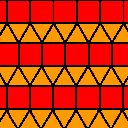dan's geometry lesson
©1997-2016 - all rights reserved - dan bach @dansmath
In the beginning . . . Euclid (about 2500 years ago, in his famous Elements) started his definitions with:
"A point is that which has no part."
You could say the same about my hair, but he meant that a point is an idealized mathematical concept, not a sloppy dot on a piece of paper. He then went on to define lines, circles, polygons, and came up with Euclid's Five Postulates, dealing with betweenness and uniqueness of circles and parallel lines and such. If you drop the fifth postulate, you enter the evil world of "Non- Euclidean" geometry, where you get zero (Riemannian) or an infinite number (hyperbolic) of lines thru a point 'parallel' to a given line. Get the point?
Lines, Rays, and Polygons
A line has infinite length, but a segment has length equal to the distance between its two endpoints.
A ray starts at one point and goes on and on forever (like that Madonna song).
A polygon consists of a series of segments proceeding from point to point; the popular idea of a polygon is that it's 'simple' (no self-intersections) 'closed' (a loop, not a path), and usually 'convex' (no scooped out parts).
Let's count the sides: triangle (3), quadrilateral (4), pentagon, hexagon, heptagon, octagon, nonagon, decagon, . . .
A polygon is regular if all its sides are the same length and all its interior angles are equal, like a square or a stop sign (octagon).
Here's a partial table of the number of sides n of a regular polygon and the interior angle a (degrees) for each; the formula being:
a = 180 (n – 2) / n
n : 3 4 5 6 8 9 10 12
a : 60 90 108 120 135 140 144 150
Tessellations (by popular demand!)
Often called tilings or mosaics, tessellations are (possibly repeating) patterns of polygons that fill the entire plane. The most common one is like a chessboard, or graph paper, or screen door, or ... ?
Two types of repeating tessellations made of regular polygons are regular and semi-regular.
regular tessellations:
Regular tessellations consist of all the same type of polygon, like all squares, and semi-regular ones have more than one type, like hexagons and triangles. Both types are required to have the same set of polygons (in the same order) at all corners.
The key is to look at the angles of the polygons at a corner; if they don't add up to 360°, then the tessellation won't work. I like the notation < 6, 6, 6 > for the tiling of all hexagons, like many bathroom floor patterns or beehives, because each vertex (corner) has three 6-sided polygons meeting there. Notice the angles add up correctly (see the table of n vs a above).
The number of regular tessellations is very limited as seen in the table above; only 60, 90, and 120 are divisors of 360, giving the three possible patterns below:
semi-regular tessellations:
The world of semi-regular tilings is larger; there are at least eight or nine of them, from the simple to the complex, found in the table below. Check that they all add up to 360, such as < 4, 8, 8 > (my kitchen floor) which gives 90 + 135 + 135 = 360. Are there any more? You decide!
Note: Although < 5, 5, 10 > adds up correctly, it's physically impossible to continue the pattern for very long. Right now I can't get captions on these images so you'll have to identify them by sight; the first one is <3,3,3,3,6>. The eyeballs ask if <3,3,6,6> exists.
Polyhedra
These are like tessellations that don't quite make it all the way around, and have to be 'bent up' into the third dimension. For example, three squares at a corner would form a cube and be called < 4, 4, 4 >.
When drawn on paper, the pattern would leave a gap of 90 deg, and this gap actually determines how many corners (vertices) the shape will have. Using the Euler characteristic of 2 for a sphere (V – E + F = 2), we can prove that the total gap must be 720 deg, so a cube has to have 720/90 = 8 total vertices. It does.
the five platonic solids
tetrahedron
< 3, 3, 3 >
4 triangles
octahedron
< 3, 3, 3, 3 >
8 triangles
hexahedron
< 4, 4, 4 >
6 squares
icosahedron
< 3, 3, 3, 3, 3 >
20 triangles
dodecahedron
< 5, 5, 5 >
12 pentagons
Coordinate Geometry
A point on the screen you're looking at (like this one: • ) has a "location" which is measured by how many pixels across and down it is from the upper left corner. These are its "screen coordinates."
In math, the coordinates of a point in the plane are measured in relation to a "central" point, the origin, first to the right, then up. The coordinates are listed as (x, y) for (over, up).
In the picture, the origin is at the + and the big dot • has coordinates (x, y) = (5, 2).
. . .|y . . 4| . . . . . . . . 3| . . . . . . . . 2| . . . . • . . . 1| . . . . . . ----0+--------------> x . .-1| 1 2 3 4 5 6 . .-2| . . . . . .
Coordinates are also used in writing equations for graphs; we can have a relation between x and y, and translate that into the language of pictures. In the first two examples below, the functions are "linear" so the graphs are straight lines.



















